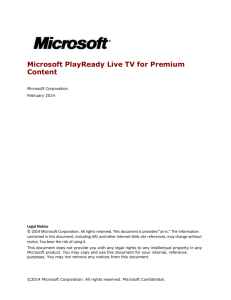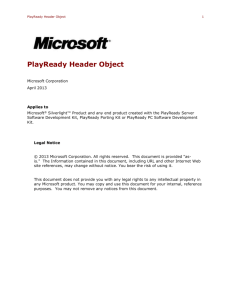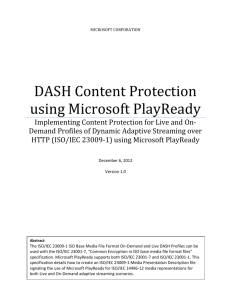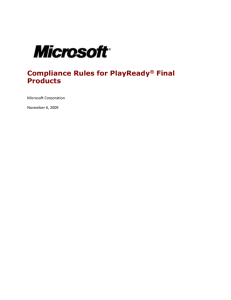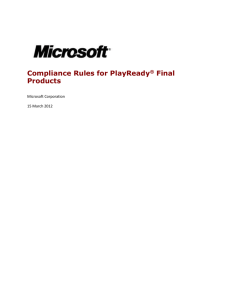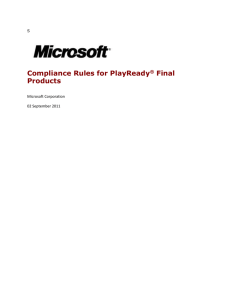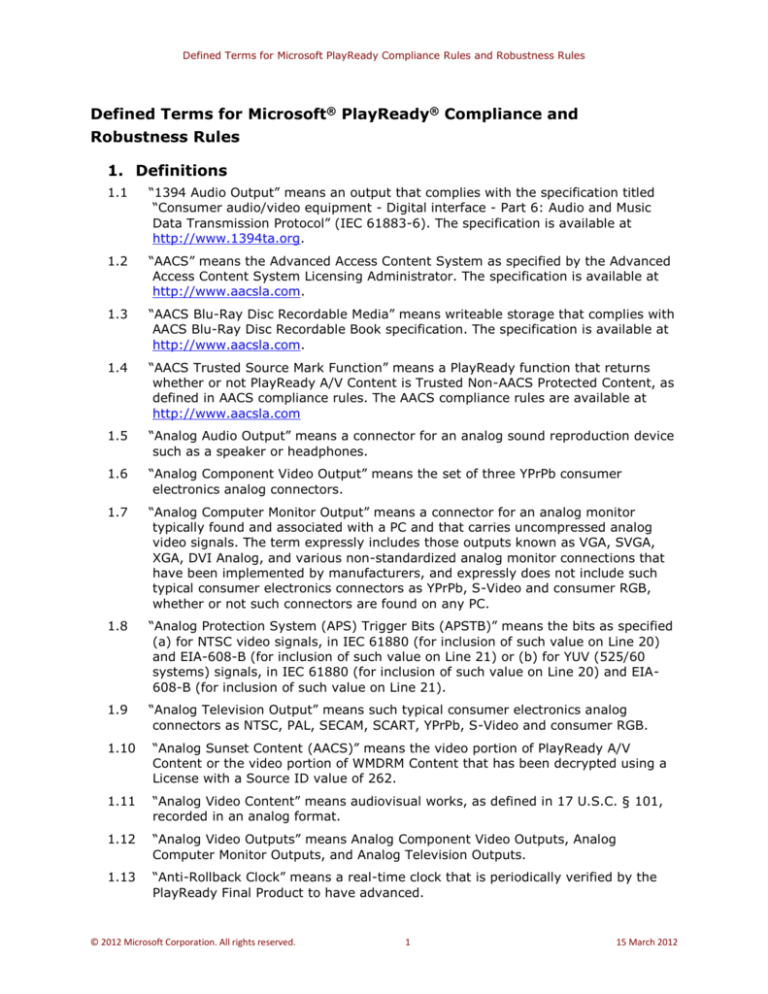
Defined Terms for Microsoft PlayReady Compliance Rules and Robustness Rules
Defined Terms for Microsoft® PlayReady® Compliance and
Robustness Rules
1. Definitions
1.1
“1394 Audio Output” means an output that complies with the specification titled
“Consumer audio/video equipment - Digital interface - Part 6: Audio and Music
Data Transmission Protocol” (IEC 61883-6). The specification is available at
http://www.1394ta.org.
1.2
“AACS” means the Advanced Access Content System as specified by the Advanced
Access Content System Licensing Administrator. The specification is available at
http://www.aacsla.com.
1.3
“AACS Blu-Ray Disc Recordable Media” means writeable storage that complies with
AACS Blu-Ray Disc Recordable Book specification. The specification is available at
http://www.aacsla.com.
1.4
“AACS Trusted Source Mark Function” means a PlayReady function that returns
whether or not PlayReady A/V Content is Trusted Non-AACS Protected Content, as
defined in AACS compliance rules. The AACS compliance rules are available at
http://www.aacsla.com
1.5
“Analog Audio Output” means a connector for an analog sound reproduction device
such as a speaker or headphones.
1.6
“Analog Component Video Output” means the set of three YPrPb consumer
electronics analog connectors.
1.7
“Analog Computer Monitor Output” means a connector for an analog monitor
typically found and associated with a PC and that carries uncompressed analog
video signals. The term expressly includes those outputs known as VGA, SVGA,
XGA, DVI Analog, and various non-standardized analog monitor connections that
have been implemented by manufacturers, and expressly does not include such
typical consumer electronics connectors as YPrPb, S-Video and consumer RGB,
whether or not such connectors are found on any PC.
1.8
“Analog Protection System (APS) Trigger Bits (APSTB)” means the bits as specified
(a) for NTSC video signals, in IEC 61880 (for inclusion of such value on Line 20)
and EIA-608-B (for inclusion of such value on Line 21) or (b) for YUV (525/60
systems) signals, in IEC 61880 (for inclusion of such value on Line 20) and EIA608-B (for inclusion of such value on Line 21).
1.9
“Analog Television Output” means such typical consumer electronics analog
connectors as NTSC, PAL, SECAM, SCART, YPrPb, S-Video and consumer RGB.
1.10
“Analog Sunset Content (AACS)” means the video portion of PlayReady A/V
Content or the video portion of WMDRM Content that has been decrypted using a
License with a Source ID value of 262.
1.11
“Analog Video Content” means audiovisual works, as defined in 17 U.S.C. § 101,
recorded in an analog format.
1.12
“Analog Video Outputs” means Analog Component Video Outputs, Analog
Computer Monitor Outputs, and Analog Television Outputs.
1.13
“Anti-Rollback Clock” means a real-time clock that is periodically verified by the
PlayReady Final Product to have advanced.
© 2012 Microsoft Corporation. All rights reserved.
1
15 March 2012
Defined Terms for Microsoft PlayReady Compliance Rules and Robustness Rules
1.14
“API” means Application Programming Interface.
1.15
“Application Secrets” means, collectively, the WMDRM or PlayReady stub library
provided to Company and secrets, such as symmetric keys and private keys, that
reside in the application binary and/or in the process space of the application.
1.16
“Audio Outputs” means Analog Audio Output, Digital Audio Output, USB Audio
Output, 1394 Audio Output, and/or MOST Audio Output.
1.17
“AGC” means the Automatic Gain Control copy control system as specified (a) for
NTSC, PAL, SECAM or YUV analog video signals, in the document entitled
“Specification of the Macrovision Copy Protection Process, Revision 7.2.H1,
October 3, 2005,” and (b) for a 480p progressive scan analog video signal, in the
document entitled “Specification of the Macrovision AGC Copy Protection
Waveforms for Products with 525p and/or 625p YPbPr Progressive Scan Outputs,
Revision 1.3 June 30, 2006.”
1.18
“A/V Content” means PlayReady A/V Content or WMDRM Content.
1.19
“Bluetooth Audio Profiles” means Advanced Audio Distribution Profile (A2DP) v1.0
or greater, Hands Free Profile (HFP) v1.0 or greater, or Headset Profile (HSP) v1.0
or greater. Bluetooth technical specifications are available at
http://bluetooth.com/Bluetooth/Technology/Building/Specifications/Default.
1.20
“Bluetooth Audio Output” means a radio frequency connector that delivers Audio
Content using Bluetooth Audio Profiles.
1.21
“Certificate” means a unique PlayReady or WMDRM object used to verify trust.
1.22
“Certificate Chain” means the set of Certificates that can trace the assessed trust
of a Certificate back to a Root Public Key.
1.23
“Certificate Security Level” means a value specified in a Certificate associated with
a PlayReady Final Product. A PlayReady Final Product may consume only Content
that has an associated License Security Level no greater than the PlayReady Final
Product’s Certificate Security Level.
1.24
“Certificate Signing Private Key” means an asymmetric private key generated by
Company for the purpose of signing Certificates.
1.25
“Certificate Signing Symmetric Key” means a symmetric key derived from a
Certificate Signing Private Key.
1.26
“Certified Output Protection Protocol” (COPP) means the protocol used to establish
a secure communications channel between an application and a graphics driver as
specified on http://msdn.microsoft.com/en-us/library/cc307975(VS.85).aspx.
1.27
“CGMS-A” means the Copy Generation Management System (Analog) as specified
(a) for NTSC analog video signals, in IEC 61880 (for inclusion on Line 20) and in
EIA-608-D (for inclusion on Line 21), (b) for PAL, SECAM or YUV analog video
signals, in IEC 61880 (for inclusion on Line 20) or in EIA-608-D (for inclusion on
Line 21) or in EIA-805 (for inclusion on Line 41) for YUV (525/60 systems) signals
or in ETS 300294 for PAL, SECAM and YUV (625/50 systems) signals, or (c) for
480p progressive scan analog video signals, in, or adapted without material
change from, EIAJ CPR1204-1 (defining the signal waveform carrying the CGMSA) and IEC 61880 (defining the bit assignment for CGMS-A).
1.28
“Circumvention Tool” means a tool whose purpose is the circumvention of one or
more Content Protection Functions.
© 2012 Microsoft Corporation. All rights reserved.
2
15 March 2012
Defined Terms for Microsoft PlayReady Compliance Rules and Robustness Rules
1.29
“Clipboard” means a mechanism to enable data sharing between or within
processes on a single Computer Product or other single device.
1.30
“Color Stripe” means the so-named copy control system as specified for analog
video signals in the document entitled “Specification of the Macrovision Copy
Protection Process, Revision 7.2.H1, October 3, 2005”.
1.31
“Company” means an entity licensed under a PlayReady Agreement to develop
and/or distribute PlayReady Final Products.
1.32
“Company Certificate” means a Certificate unique to Company issued by Microsoft
for the purpose of issuing other Certificates.
1.33
“Compliance Rules” means the Compliance Rules for PlayReady Final Products, as
amended from time to time by Microsoft.
1.34
“Computer Product” means a device that is designed or permits the end user to
install software applications thereon, including, but not limited to, personal
computers, handheld personal digital assistants (PDAs), and the like.
1.35
“Consistent with the Microsoft Implementation” means that the PlayReady Final
Product (i) provides equivalent functionality to the Microsoft Implementation (as
to any included functionality), (ii) equals or exceeds the robustness of the
Microsoft Implementation, and (iii) maintains compatibility and interoperability
with the Microsoft Implementation.
1.36
“Content” means PlayReady Content and/or WMDRM Content.
1.37
“Content Key” means a symmetric key used to encrypt and decrypt Content.
1.38
“Content Protection Functions” means functions related to protection of Content,
including but not limited to authentication, encryption, decryption, Device
Certificate signing, output protection, Metering, Secure Clock, Content revocation,
key management, rights enforcement or storing/updating information in the
PlayReady Data Stores as such term is described and required in the Microsoft
Implementation, to the extent such functions are implemented in a PlayReady
Final Product.
1.39
“Content Provider” means the entity that specified directly or indirectly the rights
and restrictions in a License.
1.40
“Content Provider Authorized Export” means a technology authorized by a Content
Provider in a License for the purpose of allowing Export to the technology.
1.41
“Contract Manufacturer Certificate” means a Certificate issued by Company and
unique to a contract manufacturer for use on Company’s behalf.
1.42
“Cryptographic Keys” means Content Keys, Device Keys, Device Certificate
Signing Keys, Domain Keys, Fallback Keys, License Integrity Keys, WMDRM Root
Public Keys, PlayReady Root Public Keys, Privacy Public Keys, and Session Keys.
1.43
“Cryptographically Random” means unpredictable, in that no polynomial-time
algorithm, given any sequence of bits, can guess the succeeding K bits with
probability greater than ½^K + 1/P(K) for any (positive) polynomial P and
sufficiently large K.
1.44
“Cryptographically Sound” means being of sufficient cryptographic strength to
render a cryptanalytic attack computationally infeasible.
© 2012 Microsoft Corporation. All rights reserved.
3
15 March 2012
Defined Terms for Microsoft PlayReady Compliance Rules and Robustness Rules
1.45
“CSS” means the Content Scrambling System as specified by the DVD Copy
Control Association (DVD CCA) in the CSS Procedural specifications version 2.9
effective January 24, 2007.
1.46
“Debugging Aids” means software/hardware components supporting debugging
and profiling tools and/or technologies, including without limitation debugging
symbols in software.
1.47
“Decode Boundary” means the amount of decoded, decrypted A/V Content present
at any given time in a PlayReady Final Product.
1.48
“Device Bound License” means a License that contains a Content Key encrypted
using a Device Public Key.
1.49
“Device Certificate” means a Certificate issued by or on behalf of Company,
assigned to a PlayReady Final Product and used, for example, to evaluate whether
the PlayReady Final Product is trusted and eligible to receive Content.
1.50
“Device Certificate Signing Keys” means asymmetric keys generated by Company
for its PlayReady Final Products for the purpose of digitally signing Device
Certificates.
1.51
“Device Group Certificate” means a WMDRM Certificate that contains information
about a PlayReady Final Product’s capabilities for the purpose of verifying a Device
Certificate.
1.52
“Device Group” means a group of PlayReady Final Products with respect to which
Company, for all PlayReady Final Products in the group, employs one or more
hardware and/or software configurations that do not differ materially in the
methods used for conforming to PlayReady compliance and robustness rules.
1.53
“Device Group Key Pair” means the public/private key pair associated with the
Device Group Certificate.
1.54
“Device Keys” means an associated pair of asymmetric keys generated by or on
behalf of Company used for purposes such as, but not limited to, decrypting
Content in PlayReady Final Products.
1.55
“Device Model Certificate” means a PlayReady Certificate that contains information
about a PlayReady Final Product’s capabilities for the purpose of verifying a Device
Certificate.
1.56
“Device Model Keys” means a pair of public and private keys used for purposes
such as, but not limited to verifying and signing Device Certificates respectively.
1.57
“Device Private Key” means the private portion of the Device Keys.
1.58
“Device Public Key” means the public portion of the Device Keys.
1.59
“Device Secrets” means Device Private Key, the private portion of the Fallback
Keys, the private portion of the Device Model Keys, the Device Secret Key, the
Certificate Signing Private Key, Certificate Signing Symmetric Key, Key File
Protection Key and the private portion of the Domain Keys.
1.60
“Device Secret Key” means a key derived from a Device Private Key.
1.61
“Digital Audio Content” means sound recordings, as defined in 17 U.S.C. § 101,
recorded in a digital format.
1.62
“Digital Audio Outputs” means any of the following digital audio signals: IEC-958,
IEC-60958, IEC-61937, HDMI, or DisplayPort.
© 2012 Microsoft Corporation. All rights reserved.
4
15 March 2012
Defined Terms for Microsoft PlayReady Compliance Rules and Robustness Rules
1.63
“Digital Literary Content” means literary works, as defined in 17 U.S.C. § 101, in
digital form, and related data that may accompany such literary works in digital
form.
1.64
“Digital Video Content” means audiovisual works, as defined in 17 U.S.C. § 101,
recorded in a digital format.
1.65
“Digital Video Outputs” means any of the following: the digital interface portion
only of Digital Visual Interface (DVI), the digital video interface portion of HDMI,
or the digital video interface portion of DisplayPort.
1.66
“Display” means to direct decrypted PlayReady Digital Literary Content to flow to
local device Outputs or local Computer Product Outputs, optionally through
intermediate local components, such as a device driver.
1.67
“DisplayPort” means the so-named industry-supported, digital audio/video
interface. The DisplayPort specification is available at
http://www.displayport.org/.
1.68
“Display Resolution” means the resolution of an image as displayed, possibly using
video processing techniques such as line doubling or scaling.
1.69
“Domain” means a group of devices, which may include Computer Products, that
share a common set of Domain Private Keys.
1.70
“Domain Bound License” means a License that contains a Content Key encrypted
using a Domain Public Key.
1.71
“Domain Certificate” means a Certificate issued by a PlayReady Server during the
Domain joining process.
1.72
“Domain Keys” means unique keys issued from the PlayReady Server used for
purposes such as, but not limited to, device and/or PC registration as part of a
Domain.
1.73
“Domain Private Key” means the public portion of the Domain Keys.
1.74
“Domain Public Key” means the public portion of the Domain Keys.
1.75
“Domain Symmetric Key” means a key derived from a Domain Private Key.
1.76
“DRI” means the OpenCable Digital Receiver Interface Protocol as specified in the
OpenCable Digital Receiver Interface Protocol Specification (OC-SP-DRI-IO2060210). The specification is available at
http://www.cablelabs.com/specifications/.
1.77
“DTCP” means the Digital Transmission Content Protection system . The
specification and license agreement are available from the Digital Transmission
Licensing Administrator, LLC at http://www.dtcp.com/.
1.78
“DTCP Sink Function” means the function of a device to obtain and decrypt
Content using DTCP.
1.79
“DTCP Source Function” means the function of a device to encrypt and transmit
Content using DTCP.
1.80
“DVI” means the digital interfaces standard Digital Video Interface 1.0 or its
successor created by the Digital Display Working Group (DDWG). The specification
is available at http://www.ddwg.org/.
1.81
“Effective Resolution” means an image having a visual equivalence of not more
than the total number of pixels per frame specified. For the avoidance of doubt, an
© 2012 Microsoft Corporation. All rights reserved.
5
15 March 2012
Defined Terms for Microsoft PlayReady Compliance Rules and Robustness Rules
image of Effective Resolution may be passed using video processing techniques
such as line doubling, scaling, or sharpening.
1.82
“Existing PlayReady Final Product” means a PlayReady Final Product, all aspects of
which are exactly the same in all respects, as any product manufactured and sold
prior to December 31, 2010; provided that notwithstanding the foregoing, Existing
PlayReady Final Products may include changes to PlayReady Final Product made
solely for one or more of the following reasons: (i) to comply with the Compliance
Rules and the Robustness Rules, (ii) to implement changes solely of Application
Secrets, Device Secrets, and/or Certificates, (iii) to implement security patches or
(iv) to implement bug fixes designed solely to cause a product to operate in
accordance with such product’s pre-existing product specification.
1.83
“Export” means to execute the translation mechanism that Transcrypts Content
from WMDRM or PlayReady into a Content Provider Authorized Export.
1.84
“Export Boundary” means the amount of decrypted Content present at any given
time in an application authorized for Export.
1.85
“Extensible Media Rights” means a binary data scheme used to convey Policy, as
specified in PlayReady DRM Extensible Media Rights Specification version 3.00, or
Windows Media® DRM Extensible Media Rights Specification version 1.76.
1.86
“Fallback Keys” means an associated pair of keys for PlayReady Final Products
used for purposes including, but not limited to, license acquisition.
1.87
“Final Product” means: (a) a software product that (i) is in a final form of design
and development with a fully functional user interface, (ii) is intended for
distribution to and/or use by end users, and (iii) displays a Company-owned brand
and/or logo as the most prominently displayed brand in the user interface (for
example, a Company-branded media player application or online service); or (b) a
hardware product that (i) is in a final form of manufacturing with a fully functional
user interface, (ii) is intended for distribution to and/or use by end users, and (iii)
bears a Company-owned brand and/or logo on the product (for example, a
Company-branded cellular phone, motor vehicle radio, portable digital music
player, handheld Internet appliance); or (c) a Secure Codec that is intended for
distribution to and/or use by end users.
1.88
“Firmware Certificate” means a Certificate issued by or on behalf of Company that
is unique to a particular model number and/or firmware revision of a PlayReady
Final Product.
1.89
“HDCP” means High-bandwidth Digital Content Protection as described in the
HDCP specification from Digital Content Protection, LLC. The specification is
available at http://www.digital-cp.com/.
1.90
“HDMI” means High-Definition Media Interface, an industry-supported, digital
audio/video interface. The HDMI specification is available at
http://www.HDMI.org/.
1.91
“HTTP” means Hypertext Transfer Protocol.
1.92
“Indirect License Acquisition” means the process of Receiving.
1.93
“Individualization” means the process of downloading and installing PlayReady
component(s) from a Microsoft service for the purpose of improving the protection
provided by PlayReady.
© 2012 Microsoft Corporation. All rights reserved.
6
15 March 2012
Defined Terms for Microsoft PlayReady Compliance Rules and Robustness Rules
1.94
“Intended Action” means an action that is permitted, with or without restriction(s),
with respect to specific Content under the Policy associated with such Content.
1.95
“Intermediate Key” means a key or set of keys used during the process of Content
Key encryption or decryption.
1.96
“Internal Video Output” means any display that is permanently internally
connected to the device on which a PlayReady Final Product is running, including,
but not limited to, a liquid crystal display (LCD).
1.97
“IP” means Internet Protocol, which is a network layer protocol that includes IPv4
and IPv6.
1.98
“IPv4” means “Internet Protocol Version 4”.
1.99
“IPv6” means “Internet Protocol Version 6”.
1.100 “ISDB” means Integrated Services Digital Broadcasting format used in Japan. The
ISDB specification can be found at www.arib.or.jp/english/.
1.101 "Key File" means the binary file containing some subset of Device Secrets
1.102 "Key File Protection Key" means the symmetric key that protects some subset of
Device Secrets in the Key File
1.103 “Key ID” means an identifier associated with a specific Content Key.
1.104 “Last Known Good Date and Time” means the last date and time recorded by
PlayReady.
1.105 “Leaf License” means a License whose Content Key is encrypted using a Content
Key in a Root License.
1.106 “License” means a WMDRM License or a PlayReady License.
1.107 “License Integrity Key” means a symmetric key used to verify that a License has
not been tampered with.
1.108 “License Security Level” means a value specified in a License associated with
specific Content that specifies the minimum Certificate Security Level necessary
for a PlayReady Final Product to consume the Content.
1.109 “Media Transfer Protocol” (MTP) means Microsoft’s Media Transfer Protocol for
device control, metadata exchange, and media transfer, as defined by the USB
Implementers Forum, Inc. The specification is available at http://www.usb.org/.
1.110 “Metering” means a feature of PlayReady designed to collect and report
information regarding the usage of Content.
1.111 “Metering Data” means the information regarding the usage of Content collected
and reported by the Metering feature.
1.112 “Microsoft Implementation” means the implementation of PlayReady Functionality
provided to Company as source code, binaries, technical documentation, tools,
and/or sample files under Company’s PlayReady Agreement.
1.113 “Microsoft Windows Media Device Manager” (WMDM) means the Windows Media
Device Manager, a subset of the programming interfaces included in the WMF
SDK.
1.114 “MOST Audio Output” means an output that complies with the Media Oriented
Systems Transport (MOST) Specification available from the MOST Cooperation.
The MOST specification is available at http://www.mostcooperation.com.
© 2012 Microsoft Corporation. All rights reserved.
7
15 March 2012
Defined Terms for Microsoft PlayReady Compliance Rules and Robustness Rules
1.115 “Network Device Certificate” means a Device Certificate assigned to a Network
Device Transmitter or a Network Device Receiver.”
1.116 “Network Device Receiver” means a product authorized by Microsoft to (a) Receive
from a Network Device Transmitter, and (b) decrypt and Pass WMDRM Content
received from a Network Device Transmitter.
1.117 “Network Device Transmitter” means a product authorized by Microsoft to
Transmit to a Network Device Receiver.
1.118 “Network Device Transmitter as a Microsoft OCUR” means a Network Device
Transmitter that is manufactured in accordance with the specification for
OpenCable Unidirectional Receiver Host Device issued by CableLabs (OCUR-I04060622), and is paired with a CableCARD.
1.119 “Network Device Transmitter as a Microsoft PBDA” means a Network Device
Transmitter device that is manufactured in accordance with Microsoft’s PBDA
specification.
1.120 “No Indication” means the L-bit bit value denoting “No Indication” based on the
SCMS category code of the device.
1.121 “Nonce” means a value that is non-repeating.
1.122 “Network Device Tuner” means either a Network Device Transmitter as a Microsoft
PDBA or a Network Device Transmitter as a Microsoft OCUR.
1.123 “Orange Book CD” means a recordable or rewritable compact disc conforming to
the Orange Book specifications developed by Philips and Sony.
1.124 “Outputs” means any of the following: Analog Audio Output, Analog Computer
Monitor Output, Analog Television Output, Analog Component Video Output,
Digital Audio Output, Digital Video Output, Internal Video Output, Bluetooth Audio
Output, WirelessHD Output, or USB Audio Output. Unknown Output (as defined
herein), Transmitting (as defined herein) and Exporting are not Outputs.
1.125 “Output Control” means restrictions included in Policy that must be applied when
Passing decrypted A/V Content, including but not limited to Output Protection
Levels.
1.126 “Output Protection Level” means a value included in a License that corresponds to
the output protection that must be applied when Passing decrypted A/V Content.
The Output Protection Level may be determined and assigned by the Content
Provider or may be assigned by the Microsoft Implementation for specific
categories of A/V Content.
1.127 “Pass” means to direct decrypted A/V Content to flow to local device outputs or
local Computer Product outputs, optionally through intermediate local
components, such as a decoder or device driver.
1.128 “Payload Key” means a symmetric key used to encrypt or decrypt individual
payloads of A/V Content during Export.
1.129 “PC” means a Computer Product running any of the family of Microsoft Windows ®
operating systems with PlayReady.
1.130 “Persistent Storage” means storage that can retain data for an indefinite period of
time after power is withdrawn.
1.131 “Personally Identifiable Information” means any information that can be used to
identify, contact, or locate end users of PlayReady.
© 2012 Microsoft Corporation. All rights reserved.
8
15 March 2012
Defined Terms for Microsoft PlayReady Compliance Rules and Robustness Rules
1.132 “PlayReady” means the Microsoft PlayReady® content access and protection
technology.
1.133 “PlayReady A/V Content” means Digital Audio Content or Digital Video Content
that has been encrypted using PlayReady.
1.134 “PlayReady Agreement” means the agreement(s) under which Microsoft licenses
entities to develop and distribute products that include implementations of
PlayReady.
1.135 “PlayReady Certificate” means a Certificate provided by Microsoft for the purpose
of enabling PlayReady Final Products to access PlayReady Functionality.
1.136 “PlayReady Content” means PlayReady A/V Content, PlayReady Software Content,
or PlayReady Digital Literary Content.
1.137 “PlayReady Data Stores” means the databases required for PlayReady features.
This includes, but is not limited to, license store, Secure Store, metering store,
metering certificate store, domain certificate store, and license synchronization
store, as required by the Microsoft Implementation.
1.138 “PlayReady Device Bridge” (PRDB) means a PlayReady Portable Device authorized
by Microsoft to issue a WMDRM License to a Portable Device.
1.139 “PlayReady Digital Literary Content“ means Digital Literary Content that has been
encrypted using PlayReady.
1.140 “PlayReady Final Product” means a Final Product that includes PlayReady as more
specifically described in a PlayReady Agreement.
1.141 “PlayReady Functionality” means implementation of features of the PlayReady
Server Software Development Kit, PlayReady PC SDK or PlayReady Device Porting
Kit to perform PlayReady tasks.
1.142 “PlayReady License Chain” means a combination of a PlayReady Root License and
a PlayReady Leaf License.
1.143 “PlayReady License” means a data structure that contains, but is not limited to, (i)
an encrypted Content Key or an encrypted key used to decrypt a Content Key
associated with specific PlayReady Content, and (ii) PlayReady Policy associated
with specific PlayReady Content.
1.144 “PlayReady MTP Extensions Technical Documentation” means the technical
documentation included in the Microsoft Implementation that describes how to call
PlayReady from MTP.
1.145 “PlayReady Network Device Receiver” means a PlayReady Final Product
implementing Network Device Receiver functionality.
1.146 “PlayReady Network Device Transmitter” means a PlayReady Final Product
implementing Network Device Transmitter functionality.
1.147
“PlayReady PC Application” means a PlayReady Final Product that uses the
PlayReady PC SDK.
1.148 “PlayReady PC SDK” means PlayReady PC Software Development Kit provided
under a PlayReady Agreement.
1.149 “PlayReady Policy” means the description of the actions permitted and/or required
with respect to PlayReady Content and restrictions on those actions as described
in the PlayReady License associated with the PlayReady Content.
© 2012 Microsoft Corporation. All rights reserved.
9
15 March 2012
Defined Terms for Microsoft PlayReady Compliance Rules and Robustness Rules
1.150 “PlayReady Portable Device” means a PlayReady Final Product that can decrypt
and Pass decrypted A/V Content saved locally on the device, Run decrypted
PlayReady Software Content, Transmit and Receive.
1.151 “PlayReady Restricted Functionality Portable Device” means a PlayReady Final
Product that can Receive, Transmit, and/or decrypt and Pass only WMDRM
Content saved locally on the device.
1.152 “PlayReady Restricted Functionality Network Device Receiver” means a PlayReady
Final Product that can only act as a Network Device Receiver.
1.153 “PlayReady Root Public Key” means a public key controlled by Microsoft that is
trusted by a PlayReady Final Product.
1.154 “PlayReady Secure Codec” means a PlayReady Final Product that is a Secure
Codec.
1.155 “PlayReady Server” means a Computer Product licensed under a PlayReady
Agreement to use the PlayReady Server Software Development Kit, for purposes
such as, but not limited to issuing PlayReady Licenses.
1.156 “PlayReady Software Content” means Software Content encrypted using
PlayReady.
1.157 “Policy” means PlayReady Policy and/or WMDRM Policy.
1.158 “Portable Device” means a PlayReady Portable Device or a device implementing
WMDRM-PD.
1.159 “Privacy Public Key” means a key provided by Microsoft for the purpose of
encrypting sensitive communication sent over a public network.
1.160 “Professional Tools” means professional tools or equipment, such as logic
analyzers, chip disassembly systems, in-circuit emulators and their software
equivalents, disassemblers, loaders, or patchers, such as would be used primarily
by persons of professional skill and training, but not including either (i)
professional tools or equipment that are made available on the basis of a nondisclosure agreement or (ii) Circumvention Tools.
1.161 “Protocol Secrets” means all numerical, algorithmic and implementation secrets
related to protocol execution.
1.162 “Receive” means to obtain Licenses from (i) the Microsoft Windows Media Device
Manager (or a successor thereof, however named), (ii) WPD, (iii) a Network
Device Transmitter, or (iv) a device implementing MSDB or PRDB.
1.163 “Revocation Data” means data contained in a revocation information structure.
1.164 “Revocation Data Timestamp” means the date and time information used to
determine when the Revocation Data was created.
1.165 “Revocation Information Version” means the version number of Revocation Data.
1.166 “Rights Mapping” means the mapping of rights and restrictions from one content
protection system to another content protection system.
1.167 “Robustness Rules” means the Robustness Rules for PlayReady Final Products as
amended from time to time by Microsoft.
1.168 “Root License” means a Domain Bound License or a Device Bound License whose
Content Key is used to encrypt a Content Key in a Leaf License.
© 2012 Microsoft Corporation. All rights reserved.
10
15 March 2012
Defined Terms for Microsoft PlayReady Compliance Rules and Robustness Rules
1.169 “Root Public Key” means a public key controlled by Microsoft that is trusted by
PlayReady Final Products.
1.170 “RTSP” means the Real Time Streaming Protocol as defined in the IETF RFC 2326
– Real time Streaming Protocol.
1.171 “Run” means for software on a processor or virtual machine of a device, which
may include a Computer Product, to perform an instance of decrypted PlayReady
Software Content, optionally as a new operating system process.
1.172 “Salt Value” means the 64-bit value generated by the PlayReady Final Product to
create a Payload Key.
1.173 “SCMS” means Serial Copy Management System as specified for digital audio in
IEC-958, IEC-60958 or IEC-61937.
1.174 “SD Interlace Modes” mean composite video, S-Video, 480i component video and
576i video.
1.175 “Secure Audio Device Drivers” means audio device drivers that either (a) are not
capable of being replaced by an end user or (b) (i) are verified not to have been
modified, (ii) are trusted not to expose decrypted Content, and (iii) ensure,
through encryption or other means, that only the protected driver is capable of
receiving Content. For avoidance of doubt, a PlayReady Final Product that
prevents end users from upgrading the audio device drivers is considered to have
Secure Audio Device Drivers.
1.176 “Secure Clock” means a hardware real-time clock that has been designed to resist
unauthorized access at the level defined in the Robustness Rules.
1.177 “Secure Clock Service” means an Internet service authorized by Microsoft for the
purpose of providing the current Universal Time Coordinated (UTC) date and time
through a protocol designed to restrict access.
1.178 “Secure Clock State” means the date and time information reported by the Secure
Clock.
1.179 “Secure Codecs” means audio and/or video codecs that either (a) are not capable
of being replaced by an end user or (b) (i)are verified not to have been modified,
(ii) are trusted not to expose decrypted compressed Content, and (iii) prevent
intermediate software from accessing Content. For avoidance of doubt, a
PlayReady Final Product that prevents end users from replacing the codecs is
considered to have Secure Codecs.
1.180 “Secure Store” means a data store that (a) is designed to restrict unauthorized
access at a level defined in the Robustness Rules and (b) is used to Store
information, including but not limited to, state conveyed in a License such as play
count and relative expiration.
1.181 “Secure Time Source” means a time source that has been designed to restrict
unauthorized access at the level defined in the Robustness Rules.
1.182 “Serial Number” means a unique identifier with a length of 128 bits.
1.183 “Service ID” means a globally unique identifier used to identify a service offered
by Company.
1.184 “Session Key” means a symmetric key used for purposes such as, but not limited
to, encryption and decryption of data in a session.
© 2012 Microsoft Corporation. All rights reserved.
11
15 March 2012
Defined Terms for Microsoft PlayReady Compliance Rules and Robustness Rules
1.185 “Software Content” means machine code, byte code and/or interpreted
programming languages, and related data that may accompany the foregoing.
1.186 “Source ID” means a Policy contained in a License used for purposes such as, but
not limited to, identifying a content protection system that was the source of the
Content.
1.187 “Specialized Tools” means specialized electronic tools that are widely available at
a reasonable price, such as memory readers and writers, debuggers, decompilers,
or similar software development products, but not including Circumvention Tools.
1.188 “Specifically Set” means to set a Trust Value, for example the Serial Number, in
such a manner as to violate the condition of uniqueness as prescribed by the
applicable compliance rules and/or robustness rules for that Trust Value.
1.189 “Store” means to write data into a PlayReady Data Store.
1.190 “Stream Rendering Application” means an application other than the PlayReady
Final Product that (i) Passes Content only to Outputs approved by these
Compliance Rules, (ii) does not expose or cache decrypted Content, (iii) is digitally
signed by Company to enable execution on PlayReady Portable Devices or
Network Device Receivers only, (iv) is verified by Company not to have been
modified, and (v) is tested by Company to ensure compliance with clauses (i) and
(ii).
1.191 “Temporary Storage” means a storage buffer that cannot retain data in usable
form for an indefinite period of time after power is withdrawn.
1.192 “Text-to-Speech” means a mechanism to translate text into audio.
1.193 “Timer State” means the state of the timing mechanism used to measure
durations of time.
1.194 “Transcrypt” means to convert from a first content protection format to a second
content protection format, while mapping rights and restrictions from the first
content protection format to the second content protection format.
1.195 “Transmit” means to send Licenses to a device implementing PlayReady or
WMDRM.
1.196 “Transmitter” means a product authorized by Microsoft to Transmit.
1.197 “Trusted Value” means a value that PlayReady Final Products must resist attempts
to modify or set, as specified in the Robustness Rules. Trusted Values include
Device Secrets, Serial Number, Secure Clock State, Last Known Good Date and
Time, and Revocation Data.
1.198 “UltraViolet™ Download” means Content associated with a persistent UVVU DRM
License.
1.199 “UltraViolet™ Streaming” means Content associated with a non-persistent UVVU
DRM License.
1.200 “Unknown Output” means an output type that cannot be determined by the
PlayReady Final Product using all commercially reasonable technical mechanisms.
1.201 “Unrestricted Audio Outputs” means Analog Audio Outputs and USB Audio
Outputs.
1.202 “USB” means Universal Serial Bus.
© 2012 Microsoft Corporation. All rights reserved.
12
15 March 2012
Defined Terms for Microsoft PlayReady Compliance Rules and Robustness Rules
1.203 “USB Audio Output” means a speaker, headphone or other sound reproduction
device attached that complies with the Universal Serial Bus (USB) Audio
Specification available from the USB Forum.
1.204 “User Accessible Bus” means a data bus that is designed for end user upgrades or
access, such as PCMCIA, device bay, IEEE 1394, PCI buses with user accessible
sockets or Card bus. A User Accessible Bus does not include point-to-point buses,
such as graphics buses, memory buses, CPU buses, and internal PCI buses, or
similar portions of a device's internal architecture that do not permit access to
decrypted Content in a form usable by end users.
1.205 “Validation State” means the Network Device Transmitter stored data associated
with a Network Device Receiver that identifies the current authorized and
registered state of the Network Device Receiver.
1.206 “Video Outputs” means Analog Television Outputs, Digital Video Outputs and
Internal Video Outputs.
1.207 “Widely Available Tools” means general-purpose tools or equipment that are
widely available at a reasonable price, such as screwdrivers, jumpers, clips, file
editors, and soldering irons, but not including Circumvention Tools.
1.208 “WirelessHD” means the WirelessHD protocol. The WirelessHD specification and
license are available at http://www.wirelesshd.org/.
1.209 “WirelessHD Output” means a radio frequency connector that delivers Content
using WirelessHD.
1.210 “WMDRM” means Windows Media Digital Rights Management technology.
1.211 “WMDRM Base License” means a data structure that contains, but is not limited to,
a reference WMDRM Policy from which a License is derived in a manner Consistent
with the Microsoft Implementation.
1.212 “WMDRM Certificate” means a Certificate provided by Microsoft for the purpose of
enabling PlayReady Final Products to access WMDRM Functionality.
1.213 “WMDRM Content” means Digital Audio Content and/or Digital Video Content
encrypted using WMDRM.
1.214 “WMDRM Functionality” means implementation of features of the PlayReady
Device Porting Kit to perform WMDRM tasks.
1.215 “WMDRM License” means a data structure that contains, but is not limited to, (i)
an encrypted Content Key or an encrypted key used to decrypt a Content Key
associated with specific WMDRM Content, and (ii) WMDRM Policy associated with
specific WMDRM Content.
1.216 “WMDRM Policy” means the description of the actions permitted and/or required
with respect to WMDRM Content, and restrictions on those actions as described in
the WMDRM License associated with the WMDRM Content.
1.217 “WMDRM-ND License” means a WMDRM License using the Extensible Media Rights
binary data schema.
1.218 “WMDRM-ND Protocol” means a protocol used by Network Device Transmitters
and Network Device Receivers to Transmit and Receive respectively.
1.219 “WMDRM-ND Registration Seed” means a value generated by a Network Device
Transmitter used to derive Session Keys as defined in the WMDRM-ND
Specification.
© 2012 Microsoft Corporation. All rights reserved.
13
15 March 2012
Defined Terms for Microsoft PlayReady Compliance Rules and Robustness Rules
1.220 “WMDRM-ND Specification” means a document published by Microsoft that defines
the protocol used between a Network Device Transmitter and a Network Device
Receiver.
1.221 “WMDRM-ND” means WMDRM for Network Devices.
1.222 “WMDRM-PD” means WMDRM for Portable Devices.
1.223 “WMDRM-PD License” means a WMDRM License in XML format.
1.224 “WMF SDK” means Windows Media Format 11 Software Development Kit.
1.225 “WMRM Server” means a Computer Product licensed by Microsoft to utilize the
Windows Media Rights Manager Software Development Kit for purposes such as,
but not limited to, issuing WMDRM Licenses.
1.226 “WPD” means the Windows Portable Device infrastructure for the Microsoft
Windows family of operating systems.
© 2012 Microsoft Corporation. All rights reserved.
14
15 March 2012

